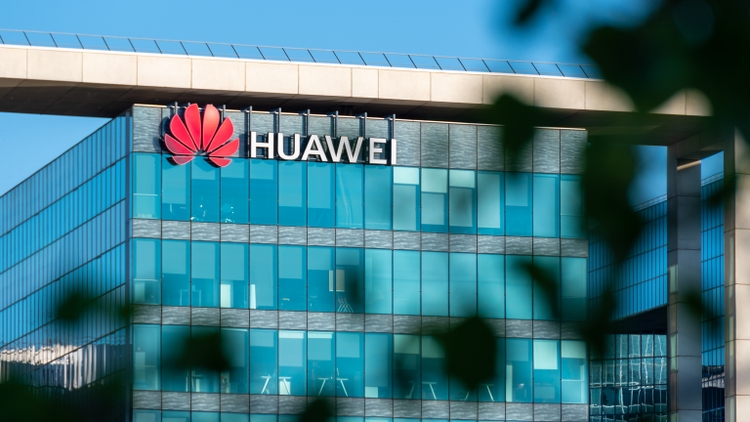Business
Huawei Launches Ambitious AI Chip Roadmap to Rival Nvidia

Huawei Technologies has introduced a new roadmap for its artificial intelligence (AI) chip development, aiming to compete directly with Nvidia’s established market presence. On Thursday, the company unveiled its SuperPod technology, which integrates AI chips with over 15,000 graphics cards. This initiative culminates in a supercluster that boasts a staggering 1 million graphics cards, showcasing Huawei’s ambition to reshape the AI landscape.
The unveiling of the SuperPod marks a significant milestone for Huawei, particularly as it seeks to enhance its position in the global semiconductor industry. The company plans to release four iterations of its Ascend chips by 2028, with each version designed to improve processing capabilities and efficiency. These advancements are expected to address a growing demand for powerful AI solutions across various sectors.
Strategic Positioning Against Nvidia
Nvidia, a dominant player in the AI chip market, has set a high standard with its cutting-edge technology. Huawei’s strategy appears to be a direct response to Nvidia’s success, particularly in the realm of large-scale AI applications. By developing the SuperPod, Huawei aims to provide a competitive alternative to Nvidia’s offerings, potentially enabling organizations to leverage AI more effectively.
The SuperPod technology allows for massive parallel processing, which is crucial for handling extensive datasets. Huawei’s design enables users to access computing power on an unprecedented scale, further enhancing the capabilities of AI applications. This technological leap could attract businesses seeking robust AI solutions while reducing their reliance on Nvidia’s infrastructure.
In addition to the immediate implications for competition, Huawei’s advancements in AI chip technology may have broader ramifications for the global semiconductor market. The company’s commitment to producing high-performance chips could stimulate innovation and investment, potentially leading to a more diversified ecosystem of AI solutions.
Future Outlook and Industry Impact
Looking ahead, Huawei’s roadmap suggests a clear focus on establishing itself as a significant player in the AI sector. The planned releases of the Ascend chips not only reflect the company’s technological aspirations but also its determination to capture market share from established competitors like Nvidia. As the demand for AI-driven technologies continues to rise, Huawei’s efforts may catalyze changes in consumer preferences and industry standards.
The success of the SuperPod and the upcoming Ascend chips will largely depend on their performance in real-world applications. If Huawei manages to deliver on its promises, the company could position itself as a formidable contender in the AI chip market. This development is particularly noteworthy given the ongoing global competition in technology and innovation, as companies strive to meet the challenges of an increasingly digital economy.
Huawei’s announcement is a clear indication that the landscape of AI technology is set to evolve rapidly. With its new initiatives, the company is not only challenging the status quo but also paving the way for future innovations in artificial intelligence. As the industry watches closely, the coming years will reveal whether Huawei can successfully disrupt Nvidia’s stronghold and emerge as a leader in the AI chip market.
-

 Science4 months ago
Science4 months agoToyoake City Proposes Daily Two-Hour Smartphone Use Limit
-

 Top Stories4 months ago
Top Stories4 months agoPedestrian Fatally Injured in Esquimalt Collision on August 14
-

 Health4 months ago
Health4 months agoB.C. Review Reveals Urgent Need for Rare-Disease Drug Reforms
-

 Technology4 months ago
Technology4 months agoDark Adventure Game “Bye Sweet Carole” Set for October Release
-

 World4 months ago
World4 months agoJimmy Lai’s Defense Challenges Charges Under National Security Law
-

 Lifestyle4 months ago
Lifestyle4 months agoVictoria’s Pop-Up Shop Shines Light on B.C.’s Wolf Cull
-

 Technology4 months ago
Technology4 months agoKonami Revives Iconic Metal Gear Solid Delta Ahead of Release
-

 Technology4 months ago
Technology4 months agoApple Expands Self-Service Repair Program to Canada
-

 Technology4 months ago
Technology4 months agoSnapmaker U1 Color 3D Printer Redefines Speed and Sustainability
-

 Technology4 months ago
Technology4 months agoAION Folding Knife: Redefining EDC Design with Premium Materials
-

 Technology4 months ago
Technology4 months agoSolve Today’s Wordle Challenge: Hints and Answer for August 19
-

 Business4 months ago
Business4 months agoGordon Murray Automotive Unveils S1 LM and Le Mans GTR at Monterey









